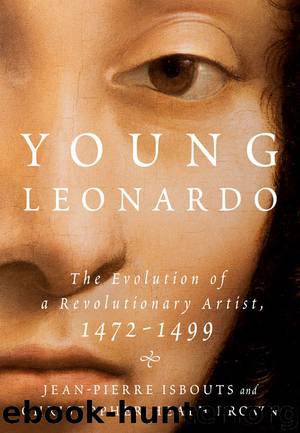Young Leonardo: The Evolution of a Revolutionary Artist, 1472-1499 by Jean-Pierre Isbouts & Christopher Heath Brown

Author:Jean-Pierre Isbouts & Christopher Heath Brown [Isbouts, Jean-Pierre]
Language: eng
Format: epub
Publisher: St. Martin's Press
Published: 2017-05-23T05:00:00+00:00
Vincenzo Foppa, Crucifixion, ca. 1456.
Nevertheless, the stock expressions of the figures, as well as the hobbyhorse quality of the mounted Roman detail, mark Montorfano’s Crucifixion as one firmly rooted in the transitional style from Late Gothic to Early Renaissance, which is typical of the art of Lombardy in the late fifteenth century. The fresco features all the key protagonists of the Crucifixion according to its medieval canon: Christ and the two thieves (or “bandits”) who were crucified with him, the Virgin Mary (dressed in aquamarine robes, as per fifteenth-century custom), Mary Magdalene and Salome, the centurion and the lance bearer, and the soldiers casting lots.
At the same time, however, the Dominican friars demanded that many more figures be called upon to populate the vast space, including Thomas of Aquinas and Dominic, the two principals of the Dominican Order. Among the clutch of saints to the left are two prominent figures in local Milanese lore, Saint Vincent and Saint Peter Martyr. Lastly, the area around the crosses proper is packed with a large group of people, including numerous Roman officers, foot soldiers, and a number of spectators, including several local worthies.
No doubt, this desire to populate the composition with many more figures than the Passion story calls for was prompted by the sheer size of the wall that Montorfano had to cover. Whereas Leonardo resolved this problem by the sheer monumentality of his figures, Montorfano fell back on the device that Gaddi had previously employed in his frescoes in Florence: by crowding the space with lots of characters and enlivening this crowd with a variety of color, pose, and orientation.
A striking figure has detached himself from the crowd to look straight at the beholder. Arguably, this is John, the beloved disciple who, according to Christian tradition, was also identified with John the Evangelist; his penetrating gaze, directed straight at us, suggests that he is the narrator of the tragic events taking place in the fresco.
Immediately to his right is a group of soldiers throwing dice over Jesus’ garments, as described in the Gospel of John: “They divided my clothes among themselves, and for my clothing they cast lots” (Psalm 22:18; John 19:24). The dice show the numbers 1, 6, and 4, which may refer to John 16:4: “I did not say these things to you from the beginning, because I was with you. But now I am going to him who sent me.”
Download
This site does not store any files on its server. We only index and link to content provided by other sites. Please contact the content providers to delete copyright contents if any and email us, we'll remove relevant links or contents immediately.
The Secret History by Donna Tartt(18237)
Red Sparrow by Jason Matthews(5208)
Harry Potter 02 & The Chamber Of Secrets (Illustrated) by J.K. Rowling(3561)
In a Sunburned Country by Bill Bryson(3379)
Drawing Cutting Edge Anatomy by Christopher Hart(3304)
Figure Drawing for Artists by Steve Huston(3277)
Harry Potter and the Prisoner of Azkaban (Book 3) by J. K. Rowling(3126)
The Daily Stoic by Holiday Ryan & Hanselman Stephen(3117)
Japanese Design by Patricia J. Graham(3008)
The Roots of Romanticism (Second Edition) by Berlin Isaiah Hardy Henry Gray John(2826)
Make Comics Like the Pros by Greg Pak(2767)
Stacked Decks by The Rotenberg Collection(2701)
Harry Potter and the Deathly Hallows (7) by J.K. Rowling(2557)
Draw-A-Saurus by James Silvani(2516)
Tattoo Art by Doralba Picerno(2499)
On Photography by Susan Sontag(2495)
Foreign Devils on the Silk Road: The Search for the Lost Treasures of Central Asia by Peter Hopkirk(2393)
Churchill by Paul Johnson(2375)
The Daily Stoic by Ryan Holiday & Stephen Hanselman(2357)
